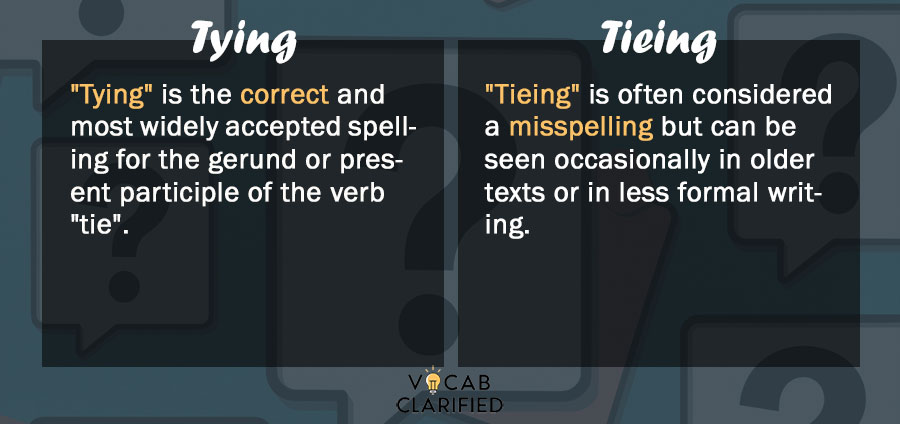Ever found yourself writing an email or text and stopping to ponder whether it is “tying” or “tieing”?
If you have ever typed one, deleted it, and then typed the other, unsure of which is correct, you are not alone. This article aims to dissolve the fog surrounding “tying” and “tieing”, guiding you to a clearer understanding and more confident usage.

Understanding Tying and Tieing
Tying: Definition and Usage
“Tying” is the correct and most widely accepted spelling for the gerund or present participle of the verb “tie”. It means to make a knot or bow in something, like shoelaces, strings, or ropes. This form is used universally in both British and American English.
For example:
- After tying her shoes, she stood up to test their fit.
- He spends his weekends tying knots for his sailing hobby.
Tieing: Definition and Usage
On the other hand, “tieing” is often considered a misspelling but can be seen occasionally in older texts or in less formal writing. The confusion likely stems from the general rule of changing ‘y’ to ‘ie’ when adding endings in words ending in ‘e’, such as dying from die, or lying from lie. However, for “tie”, the correct form remains “tying”. For instance:
- Incorrect: She was busy tieing ribbons on all the gifts.
- Correct: She was busy tying ribbons on all the gifts.
Side-by-Side Comparison
To further clarify the differences and help you decide which to use, here’s a side-by-side comparison:
| Aspect | Tying | Tieing |
| Definition | Making a knot or bow | Often a misspelling |
| Common Usage | “He is tying his shoes.” | Occasionally seen in less formal contexts |
Key Differences
When deciding between “tying” and “tieing”, consider the formality and accuracy of the context. “Tying” is always the correct form in edited, formal, and most informal texts.
The use of “tieing” might occasionally slip through in less formal or older texts but is generally considered an error today.
Everyday Usage Examples
Let’s delve deeper with more examples to illustrate how “tying” fits into everyday language:
- She is adept at tying complex knots, which comes in handy during her climbing expeditions.
- He was tying up the final details of the event, ensuring everything would run smoothly.
FAQ: Tying vs. Tieing
It’s “tying up.” This phrase is used when you’re securing something with a rope or similar material, or when you’re finalizing details of a task.
The correct phrase is “tying the knot.” This is a common expression used to describe getting married.
“Tieing” is actually a common misspelling of “tying.” The correct term, “tying,” refers to the process of making a knot or securing something with a tie.
“Tying in” means to connect or link things together. In conversation or writing, it can refer to integrating ideas or topics in a way that they relate well to each other. In physical contexts, it could mean physically connecting things.
Conclusion
Now that you’ve seen “tying” in action, any confusion with “tieing” should be dissipating. Remember, the best way to get better at language details is to learn and practice regularly. Use this guide to help you, and soon, picking the right word will be easy.
Whether you’re writing a novel, an email, or a text message, sticking to “tying” will ensure your English is flawless.

